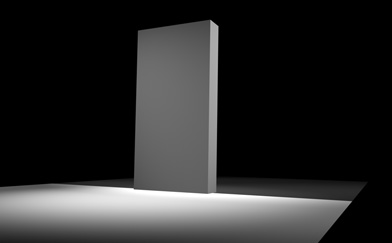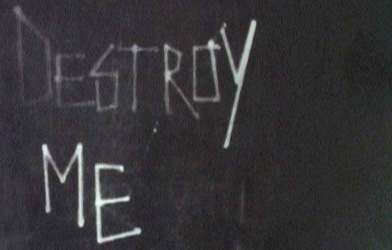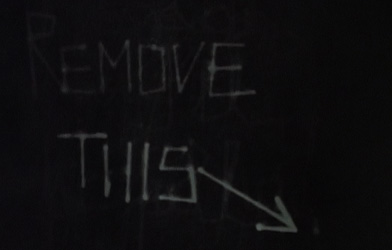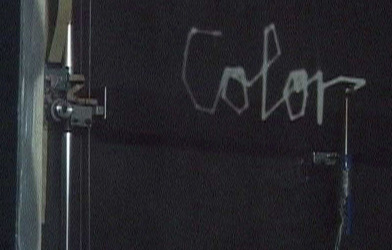Related Categories: Alternative Interfaces | Art Installations
Summary:
A self-inscribing wall, El Muro is an installation piece designed by Willy Sengewald and Richard The in 2004 as part of the “Sensitive Skin” project at the Berlin University of the Arts Digital Media course. The large monolith of El Muro stands alone in a darkened room, and produces graffiti on its surface that appears to write itself. The project calls for the dividing lines of urban and architectural space to be read — and re-read — as built expressions of political reality and as communications media. The walls to which El Muro refers not only include the borders of Berlin, Israel-Palestine, and US-Mexico, but also the anonymous urban walls that become advertising and graffiti canvases, as well as the wall as an abstract architectural element. In each case, the support structures of the built world become self-reflexive reading interfaces.

Rendering of the project.
The clearest wall referent for this installation (developed in Berlin) is the Berlin Wall. The inscriptions produced on the surface of El Muro are in part taken from wall graffiti that covered the former urban barrier. As the words and images disappear, they highlight the ephemerality of both writing and its surfaces. The artists refer to other walls, however, including those in development between Israel and Palestine and between the United States and Mexico.

Image of writing appearing on the surface of El Muro.
Sengewald and The ask, “Who is protected by this wall? Who is included? Who is excluded? Why do people or states need these walls?” As an object, the wall is important for this project beyond its large-scale political incarnations. El Muro also takes into account the walls that border public space more broadly understood, as a basic architectural element with multiply coded interior and exterior functions.
El Muro posits graffiti as one way to make public space out of walls themselves, which become writing surfaces for collectivities and individuals alike. Sengewald and The also look at the co-optation of these “public” surfaces by advertising and government communication. The project asks whether the writing on the walls is, in effect, a dead letter with no clear destination or an effective broadcasting medium, and what the effects of its relative efficacy might be.

Image of writing appearing on the surface of El Muro.
Not only does the writing on this project write itself, but it also has a clearly defined temporality. It highlights the spatial and temporal dimensions of reading and writing, which are localized in discrete units of time and circumscribed space at the same time that they are generalized in abstract forms. El Muro directly compares the production and destruction of writing with the production and destruction of the architectural supports, surfaces, and barriers. Much as these architectural forms have unclear addressees, the addressee of the writing on El Muro remains destabilized. According to Sengewald and The, much of the “street art” that the piece references is produced without necessary relation to audience and often remains unrecognized and ignored by the public at large. El Muro simultaneously challenges and reinforces this invisibility.
Research Context:
El Muro resituates debates about space and place that have circulated in several language- media- and geography-based disciplines. It thinks specifically about the relationship of reading to the role of space and place in social and political collectivities. The monolith makes explicit the multiple materialites of reading and treats text itself as an ephemeral landscape, allowing the project to both comment on and constitute itself as an alternative interface.
One way to position this project is in reference to other critical works that consider the role of walls in their socio-political context and wall-writing in particular. A prehistory of the work done by El Muro can be found in Elaine Scarry’s account of the perhaps similarly ephemeral graffiti adorning the now-demolished Berlin Wall, “Art on the Berlin Wall.” Her piece brings up the transparency of both architectural and media forms, and asks what levels of inscription are required to renew the visibility of an object such as the Berlin Wall. According to Scarry, “the two counterfactuals of transparency and sentience — the wish to make an impassable object passable; the wish to make an insensate surface sensate — are inevitably accompanied by this third, the wish to endow the mute object with the capacity of speech.”
El Muro’s drive endow its object with speech is countered by the wish to erase itself at almost the same moment the writing breaks through. A more recent account of the relationship between built walls and discourse, W. J. T. Mitchell’s “Christo’s Gates and Gilo’s Wall,” brings up the bodily dimensions of reading these physical structures. Mitchell claims that “the paradoxical character of seeing landscape, looking at the view, is materialized for us most vividly in the phenomena of walls and gates, the things we build around ourselves to obstruct the view, and the holes we punch in those obstructions to allow ourselves to pass through, visually and bodily.” While Mitchell deals with the stubborn physicality of a concrete barrier juxtaposed with the temporary installation piece, his focus on the multiple paradoxes attending walls and their relative passability is instructive for El Muro, which presents itself as a unit of wall, extending its reach virtually, and punctures its own surface through self-inscription.
Moreover, El Muro’s commentary on the temporality of the mass media by way of the perceived solidity of architecture pushes on the very distinction between media forms and architectural forms. Beatriz Colomina, in Privacy and Publicity: Modern Architecture as Mass Media, claims that the modernity of modern architecture is made possible by the media: “The organizing geometry of architecture slips from the perspectival cone of vision, from the humanist eye, to the camera angle. It is precisely in this slippage that modern architecture becomes modern by engaging with the media.” El Muro reverses this trajectory, reorienting new media to become more new through engagement with architecture.
Technical Analysis:
The surface of El Muro consists of a canvas layered with thermochromatic ink. Beneath the surface of the wall, a Roland DPX-3300 plotter equipped with a soldering iron inscribes words and simple illustrations. The heat of the soldering iron changes the color of the thermochromatic ink, but only temporarily. As the heat diminishes, the wall becomes a blank canvas again. The software used for the plotter is Processing.

Image of plotter inscribing the surface of El Muro.
Evaluation of Opportunities/Limitations for the Transliteracies Topic:
The design of this project as an application of “sensitive skin,” defined by the Berlin University of the Arts as “minimal media extensions in public space,” provides an interesting take on the multimedia environment. By extending public space, rethinking existing structures as reading interfaces and developing technologies to make their inscription possible, projects such as El Muro offer an alternate paradigm of the interface.
El Muro inspires a series of questions about the relationship between reading and the physical structures of public space. Its self-writing and disappearing text, combined with the apparent and symbolic permanence of the wall, makes room for a reconsideration of spatial form from the perspective of the media. The project’s proposed disregard for its own written messages, however, does complicate its status as a reading interface. This ephemerality of the project’s text alternately allows for the kind of exploration of reading in the context of multimedia environments central to the goals of Transliteracies.
Resources for Further Study:
- Project site.
- Video.
- Elaine Scarry, “Writing on the Berlin Wall.”
- Augé, Marc. Non-Places : Introduction to an Anthropology of Supermodernity. London: Verso, 1995.
- Colomina, Beatriz. Privacy and Publicity: Modern Architecture as Mass Media. Cambridge: MIT Press, 1994.
- Ibelings, Hans. Supermodernism: Architecture in the Age of Globalization. 2nd ed, Fascinations. Rotterdam: NAi Publishers, 2002.
- Mitchell, W. J. T. “Christo’s Gates and Gilo’s Wall,” Critical Inquiry Vol. 32 No. 4 (Summer 2006), 587-601.
